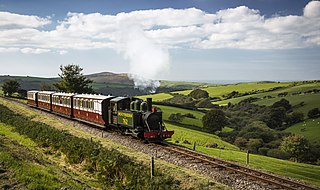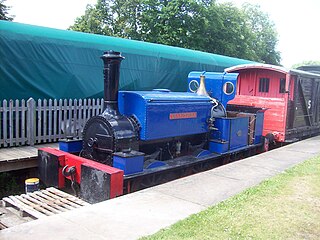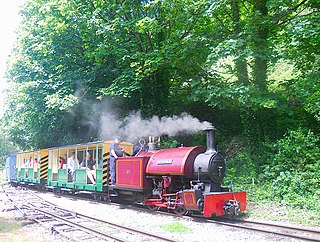
The Romney, Hythe & Dymchurch Railway (RH&DR) is a 15 in gauge light railway in Kent, England, operating steam and internal combustion locomotives. The 13+1⁄2-mile (21.7 km) line runs from the Cinque Port of Hythe via Dymchurch, St. Mary's Bay, New Romney and Romney Sands to Dungeness, close to Dungeness nuclear power station and Dungeness Lighthouse.

A Fairlie is a type of articulated steam locomotive that has the driving wheels on bogies. The locomotive may be double-ended or single ended. Fairlies are most famously associated with the Ffestiniog Railway in North Wales.

The Hunslet Engine Company is a locomotive-building company, founded in 1864 in Hunslet, England. They manufactured steam locomotives for over 100 years, and currently manufacture diesel shunting locomotives. The company is part of Ed Murray & Sons.
The War Department Light Railways were a system of narrow gauge trench railways run by the British War Department in World War I. Light railways made an important contribution to the Allied war effort in the First World War, and were used for the supply of ammunition and stores, the transport of troops and the evacuation of the wounded.

The Lynton & Barnstaple Railway (L&B) opened as an independent railway in May 1898. It was a single track, 1 ft 11+1⁄2 in narrow gauge railway and was slightly over 19 miles (31 km) long running through the rugged and picturesque area bordering Exmoor in North Devon, England. Although opened after the 1896 Light Railways Act came into force, it was authorised and constructed prior to that act. Therefore, as with all other railways, it was authorised under its own Act of Parliament and built to higher standards than similar railways of the time. In the United Kingdom it was notable as being the only narrow gauge line required to use main-line standard signalling. For a short period the line earned a modest return for shareholders, but for most of its life the L&B made a loss. In 1923 the L&B was taken over by the Southern Railway, and eventually closed in September 1935.

There were more than a thousand British narrow-gauge railways ranging from large, historically significant common carriers to small, short-lived industrial railways. Many notable events in British railway history happened on narrow-gauge railways including the first use of steam locomotives, the first public railway and the first preserved railway.

Motor Rail was a British locomotive-building company, originally based in Lewes, Sussex, they moved in 1916 to Bedford. In 1987 loco manufacture ceased, and the business line sold to Alan Keef Ltd of Ross-on-Wye, who continue to provide spares and have built several locomotives to Motor Rail designs.

Manning Wardle was a steam locomotive manufacturer based in Hunslet, Leeds, West Yorkshire, England.
The Avonside Engine Company was a locomotive manufacturer in Avon Street, St. Philip's, Bristol, England between 1864 and 1934. However the business originated with an earlier enterprise Henry Stothert and Company.
Muir Hill (Engineers) Ltd was a general engineering company based at Old Trafford, Manchester, England. It was established in the early 1920s and was significant in the production of simple rail locomotives, and later high horse power tractors and post Second World War dumpers.

F. C. Hibberd & Co Ltd was a British locomotive-building company founded in 1927 to build industrial petrol and diesel locomotives.

The Eigiau Tramway might refer to the Eigiau Quarry Tramway or to the Eigiau Reservoir Tramway.

The Baldwin Class 10-12-D was a class of narrow gauge 4-6-0PT steam locomotives built by the Baldwin Locomotive Works (USA) for the British War Department Light Railways for service in France during World War I. They were built in 1916–1917 to 600 mm gauge.

The Amberley Museum Railway is a 2 ft narrow gauge railway based at Amberley Museum, Amberley, West Sussex. It has a varied collection of engines and rolling stock ranging from 18 in gauge to 5 ft 3 in gauge. It operates passenger trains at the museum using a mixture of steam, internal combustion and battery-electric locomotives.

A Norwegian coupling or claw hammer coupling or pickaxe coupling is a manual coupling consisting of a central buffer with a mechanical hook that drops into a slot in the central buffer. The system is only found on narrow gauge railways of 1,067 mm or less, such as Western Australian Government Railways, the Ffestiniog Railway and the Welsh Highland Railway, where low speeds and reduced train loads allow a simpler system. Norwegian couplings are not particularly strong, and may be supplemented by auxiliary chains. Not all Norwegian couplings are compatible with one another as they vary in height and width, and may or may not be limited to one hook at a time.

James & Fred Howard of Britannia Ironworks, Bedford, later known simply as Howards, were one of the largest English makers of agricultural equipment, steam traction engines, and light railway equipment. At The Great Exhibition of 1851 they exhibited a range of horse-drawn implements. After World War I, Howards became part of AGE, Agricultural & General Engineers, along with many of the other British makers of similar machinery.

The South African Railways Dutton road-rail tractors of 1923 were road-rail steam tractors.

Baguley Cars Ltd was a British engineering company, specialising in railway locomotives. it was founded in 1911 by Ernest E. Baguley and subsequently acquired by Drewry Car Co to form Baguley-Drewry in 1964.

Gloddfa Ganol was a museum dedicated to the Welsh slate industry and narrow-gauge railways, situated in the Oakeley slate quarry in Blaenau Ffestiniog. It opened in 1974 and closed in 1998 following an auction of its exhibits.















